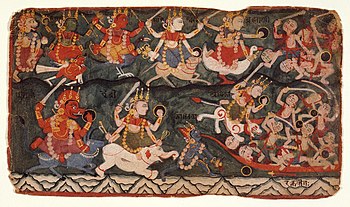Newar art[1] is the art form practiced over centuries by Newar people. The pictorial art consists of:
- Paubha[2]
- Wall paintings (murals)
- Paintings on the walls of temples
- Paintings in manuscripts (books)
- Copper and brass sculptures
- Stone sculptures
- Wooden sculptures



The Newars are the creators of most examples of art and architecture in Nepal.[3] Traditional Newar art is basically religious art. Newar devotional paubha painting, sculpture and metal craftsmanship are world-renowned for their exquisite beauty.[4] The earliest dated paubha discovered so far is Vasudhara Mandala which was painted in 1365 AD (Nepal Sambat 485).[5] The murals on the walls of two 15th-century monasteries in the former kingdom of Mustang in the Nepal Himalaya provide illustrations of Newar works outside the Kathmandu Valley.[6] Stone sculpture, wood carving, repoussé art and metal statues of Buddhist and Hindu deities made by the lost-wax casting process[7] are specimens of Newar artistry.[8] The Peacock Window of Bhaktapur and Desay Madu Jhya of Kathmandu are known for their wood carving.
Building elements like the carved Newar window, roof struts on temples and the tympanum of temples and shrine houses exhibit traditional creativity. From as early as the seventh century, visitors have noted the skill of Newar artists and craftsmen who left their influence on the art of Tibet and China.[9] Newars introduced the lost-wax technique into Bhutan and they were commissioned to paint murals on the walls of monasteries there.[10][11] Sandpainting of mandala made during festivals and death rituals is another specialty of Newar art.
Besides exhibiting a high level of skill in traditional religious art, Newar artists have been at the forefront in introducing Western art styles in Nepal. Raj Man Singh Chitrakar (1797-1865) is credited with starting watercolor painting in the country. Bhaju Man Chitrakar (1817–1874), Tej Bahadur Chitrakar (1898-1971) and Chandra Man Singh Maskey were other pioneer artists who introduced modern style paintings incorporating concepts of lighting and perspective.[12]
Paubhas or thangkas were traditionally painted by Chitrakars.[13][14]
See also
editReferences
edit- ^ Macdonald, A.W. and Stahl, Anne Vergati (1979) Newar Art: Nepalese Art during the Malla Period. New Delhi: Vikas Publishing House.
- ^ Shakya, Min Bahadur (2000) Sacred Art of Nepal: Nepalese Paubha Paintings: Past and Present. Kathmandu: Handicraft Association of Nepal.
- ^ Pal, Pratapaditya (1985). Art of Nepal: A Catalogue of the Los Angeles County Museum of Art Collection. University of California Press. p. 16. ISBN 9780520054073. Retrieved 28 March 2014.
- ^ American University (May 1964). "Sculpture, Painting and Handicrafts". Area Handbook for Nepal (with Sikkim and Bhutan). Washington, D.C.: U.S. Government Printing Office. Retrieved 28 April 2011. Page 105.
- ^ "The Stuart Cary Welch Collection". Sotheby's. Retrieved 3 June 2011.
- ^ "History". Tibetan Buddhist Wall Paintings. 2003. Retrieved 28 March 2014.
- ^ "Newar Casters of Nepal". The Huntington Photographic Archive of Buddhist and Related Art at The Ohio State University. Archived from the original on 14 June 2011. Retrieved 2 June 2011.
- ^ Bangdel, Lain S. (1989) Stolen Images of Nepal. Kathmandu: Royal Nepal Academy. Page 22.
- ^ Lieberman, Marcia R. (9 April 1995). "The Artistry of the Newars". The New York Times. Retrieved 18 May 2011.
- ^ Pommaret, Françoise (1994) Bhutan. Hong Kong: Twin Age. ISBN 978-962-217-341-5. Page 80.
- ^ Alberge, Dalya (2 January 2011). "Bhutan's Endangered Temple Art Treasures". The Observer. Retrieved 18 May 2011.
- ^ van der Heide, Susanne. "Traditional Art In Upheaval: The Development Of Modern Contemporary Art In Nepal". Arts of Nepal. Retrieved 15 December 2013.
- ^ Chitrakar, Madan (2000) Tej Bahadur Chitrakar: Icon of a Transition. Kathmandu: Teba-Chi (TBC) Studies Centre. ISBN 99933-879-7-5. Page 17.
- ^ An article about paubha
Further reading
edit- Pal, Pratapaditya. 1970. Vaisnava Iconology in Nepal: A Study in Art and Religion. (Calcutta: The Asia Society).
- Pal, Pratapaditya. 1974a. Buddhist Art in Licchavi Nepal. Marg Publications. Vol. 27. No. 3 (June 1974).
- Pal, Pratapaditya. 1974b. The Arts of Nepal, Part I: Sculpture. (Leiden: E. J. Brill).
- Pal, Pratapaditya. 1978. The Arts of Nepal, Part II: Painting. (Leiden: E. J. Brill).
- Slusser, Mary Shepherd. 1982. Nepal Mandala. Two Vols. (Princeton, New Jersey: Princeton University Press).
- Bangdel, Lain S. 1982. The Early Sculptures of Nepal. (New Delhi: Vikas Publication).
- Bangdel, Lain S. 1987. 2500 Years of Nepalese Art. (Leipzig: VEB A. Seemann Verlag).
- Bangdel, Lain S. 1987. Zweitausendfünfhundert Jahre nepalesische Kunst. (München: List Verlag).
- Schick, Jürgen. 1989. Die Götter verlassen das Land: Kunstraub in Nepal. (Graz: Akademische Druck- u. Verlagsanstalt).
- Bangdel, Lain S. 1989. Stolen Images of Nepal. (Kathmandu: Royal Nepal Academy).
- Bangdel, Lain S. 1995. Inventory of Stone Sculptures of the Kathmandu Valley. (Kathmandu: Royal Nepal Academy).
- Bangdel, Lain S. and Aryal, Mukunda Raj. 1996. A Report on the Study of Iconography of Kathmandu Valley and their Preservation and Protection. (Kathmandu: Department of Archaeology, Nepal, 2053 [1996]).
- Schick, Jürgen. 1998. The Gods are Leaving the Country: Art Theft From Nepal. [Revised English Edition]. (Bangkok: Orchid Press, 1998).
- von Schroeder, Ulrich. 2019. Nepalese Stone Sculptures. Volume One: Hindu; Volume Two: Buddhist. 1556 pages, 2898 illustrations(Visual Dharma Publications, 2019). ISBN 978-3-033-06381-5. SD card with 15,000 digital photographs of Nepalese sculptures and other subjects as public domain.
External links
edit- "The Heritage of Chitrakars". THE CHITRAKAR SOCIETY & HIMALASIA FOUNDATION. Retrieved 2022-03-26.